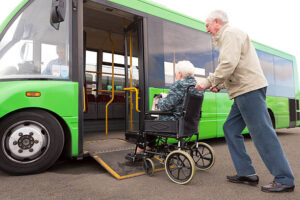
The population of those with a disability or the elderly with mobility challenges is rising. This is due to different illnesses contributing to disability and the rise in the aging population in our neighborhood. Like anyone, they deserve to travel, share moments with people, access critical services, or visit places for leisure. However, this is impossible for most of them due to transportation challenges.
Identifying transportation barriers and formulating new policies and services are necessary to help them move without strain. Many do not love driving, are incapable, or are not qualified; hence the dire need for governments, individuals, and private organizations to address these dire transportation needs.
Challenges disabled face when using transportation facilities
Lack of special facilities
One of the main challenges disabled face when dealing with transportation systems is the lack of special facilities to meet their needs. Most public transport systems, such as trains, planes, and buses, do not have seats for the disabled. This makes it challenging for the elderly and disabled as they rely on these facilities to move around. Some even lack special facilities or organizations, such as rows for the disabled.
Others do not use the trains or buses due to the lack of steps suited for the disabled to get in. This is also a challenge for the elderly using public transport systems. They find it difficult to enter the buses or trains; hence they must seek professional transportation services for the elderly. These services offer special facilities to get into the car; they have safety gear and someone to assist the elderly.
Lack of comfort
For those who do not have wheelchairs but use crutches, the seats in public transport are too congested for them to sit comfortably. They have to sit in restricted and uncomfortable positions lest they risk further injuries. The challenge rises further when the transport systems are at full capacity or congested. Movements and changing positions become a challenge due to the limited space.
Accidents
When a vehicle is in an accident, the disabled are likely to be more injured than other passengers. They are more vulnerable because they lack protective gear, such as seatbelts. Since they rely on a wheelchair and other accessories to support themselves, they can hardly use the seats available on public transport. The transport systems also lack special equipment to restrict their movement, especially when the bus or train is at high speed.
High mobility costs
The elderly or those living with disability incur high mobility costs due to the special facilities they need. Public systems may have these facilities but not all; hence safety and comfort concerns. To address these needs, they use private transport services, which can be expensive. Alternatively, they must rely on others to accompany them during the journey to help them get on the buses or trains.
Addressing the challenges
Special areas and systems
Most government transport companies are driven by the desire to create efficient systems for everyone, including the disabled. There are many adjustments to the public transportation systems to ensure the elderly and disabled are comfortable traveling. At bus stops or passenger waiting stations, there are special facilities and a dedicated waiting lounge for those with disability.
In buses, trains, and planes, particular areas are dedicated to the disabled to get the desired comfort and other safety accessories. Other assisted boarding devices, such as elevator rumps in buses and trains, enable them to move in without assistance.
Introduction of community policies in the public transport systems
Disabled sometimes have a challenge in the public transport systems due to a lack of care from their other passengers. Policies prioritizing the disabled will enable them to feel comfortable in the buses without feeling pressured by the congestion. Equally, those using the systems must also learn not to use facilities dedicated to the disabled.
Making mobility cheaper
Governments should focus on making transport facilities for the disabled cheaper. One of the interventions is making affordable vehicles suited for those with disability. This also involves making other automobile facilities such as tricycles and scooters for the disabled to enable them to travel shorter distances.
The government can also fund startups to make affordable cars and create policies to designate more parking spaces for the disabled. Besides government interventions, other private organizations should also make mobility costs cheaper to enable the elderly not to travel long distances to access such services easily. Other policies include offering free ambulatory and service vehicles for the disabled to access the needed help.
Paratransit vehicles
These transit systems operate by filling the gaps lefts by the public transport systems. For instance, they cater to the needs of the disabled, who may not have the necessary facilities in the public transportation systems. They help the disabled move without any help.
They offer a range of taxis, minivans, and buses to allow passengers to transit from one mode to another. The vehicles have facilities such as lifts and ramps to support wheelchairs. These are suitable for specific routes having a vast population of disabled and elderly using public transport systems. Moreover, they can also be ideal for door-to-door services for easy pick-up and drop-off.
Conclusion
The disabled and elderly are a critical part of society, just like other citizens; hence they need the best treatment when using public transport systems. There is a necessity to invest in essential transportation systems to help them move from one location to another. Such systems include dedicated transport systems, modified public transport, and subsidized prices of short and long-distance mobility automobiles.
